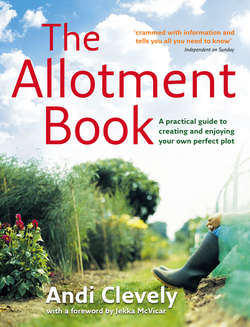Читать книгу The Allotment Book - Andi Clevely - Страница 42
USING A COLD FRAME
Оглавление▸ Spread a layer of gravel over a weed-proof membrane if you intend to use the frame for containers or for trays and plugs of seedlings (below).
▸ Fit a hinged lid with casement stays or notch a strip of wood to make a support for adjusting ventilation. Hinge the lid and prop it open to ventilate the cold frame during the day (bottom), then close it at night to keep in the heat.
▸ When not in use, prevent wooden frames from rotting by lifting them clear of the ground with a block at each corner.
▸ Stand pots and trays on a layer of gravel over a woven plastic membrane to suppress weeds and deter slugs and snails.
▸ Treat a soil-based frame like an extra vegetable bed: water, manure, mulch and rotate crops as you would in the open ground.
Fruit cages If you can disperse fruit around the plot, it is possible to harvest good crops from unprotected plants without significant losses to birds or squirrels. But smaller plantings, especially of attractive fruit such as redcurrants, raspberries, strawberries and blueberries, may be stripped before they even show colour, and some kind of protection could be vital.
An individual bush can be enclosed with netting draped like a tent over 3–4 flexible canes arched to meet at the top, where they are tied. Protect a row of raspberries or cordon redcurrants by erecting a post at each end, with several timber cross-pieces, like a telegraph pole: attach wire to these, stretched from one end of the row to the other, and arrange curtains of netting over the wires and clear of the fruit.
Gathering vulnerable fruit together in a cage is a more permanent solution. Various ready-made cages are available to buy, or you can build your own from strong bamboo canes, coppiced hazel poles or metal pipes. Erect uprights 1.8–2.1m (6–7ft) high for clear headroom, space them about 1.8m (6ft) apart, and join their tops with cross bars to support the roof. Clad the sides with 1–2cm (1/2;–3/4in) mesh plastic or wire netting (but note that squirrels easily chew through plastic), and the roof with 2cm (3/4in) plastic netting.
